Yves here. Even though this post, being VoxEU, is pretty dry, it addresses a hot topic: the idea that the economic devastation of skyrocketing unemployment and failing businesses is due to government action to tamp down the spread of coronavirus. In fact, it concludes that reactions to coronavirus are the main driver.
My small sample from a not-terribly-sensitive area (a liberal pocket in the heart of Trumpland) doesn’t lend strong support. On the one hand, when the national news started braying about infections in New York (and then in neighboring states), pretty much everyone in the geriatric age group at my gym stopped attending. But even though I started doing take-out at our favorite restaurant (which would normally never do that but the chef knows us), it was packed when I’d go to the bar (wearing a mask even then) for pick-up, and the average age was over 40. And I doubt this spot will make it; I don’t see how the better independent restaurants get back on their feet. But more generally, I saw almost no changes in behavior here, even after the governor closed all the schools. Only when non-essential businesses were shuttered as well did some people seem to internalize the message that coronavirus might be serious.
The flip side is that by being self-employed, I have little contact with worker-driven demands to shutter operations if necessary safety measures aren’t taken. Remember the closure of auto plants due to union pressure. And see in our companion post today on how meatpacking plant workers don’t want to come in and risk getting sick if their employer won’t ante up to provide adequate protection.
So that may weigh heavily in the data, as well as knock-on effects from supply chain disruptions. For instance, an auto-industry supplier I know said Mercedes closed its US plants a week sooner than they had wanted because they were unable to get a critical part from Europe due to coronavirus disruptions there.
And Alabama is one of the five worst states in observing social distancing,1 so being a a less bad section may not make much difference.
By ChaeWon Baek, Peter B. McCrory, Todd Messer, and Preston Mui, all PhDs candidate in Economics, University of California, Berkeley. Originally published at VoxEU
Stay-at-home orders have been imposed in many countries to flatten the COVID-19 pandemic curve, but it’s not clear how much economic disruption is caused directly by the orders and how much by the coronavirus. This column disentangles the two by comparing the implementation of stay-at-home policies across the US and high-frequency unemployment insurance claims. The direct effect of stay-at-home orders accounted for a significant but minority share of the overall rise in unemployment claims; unemployment would have risen even without such orders. Unless the underlying public health crisis persists, undoing stay-at-home orders will only bring limited economic relief.
Closing schools, restricting economic activity, and promoting social distance are necessary to flatten the pandemic curve (Ferguson et al. 2020), but the economic costs of implementing such lockdown policies are difficult to pin down. In the US, the most prominent of these policies is the stay-at-home (SAH) order, which typically requires people to remain at home except for tasks and work deemed essential.
Researchers have already begun quantifying the general economic disruption in the US associated with the coronavirus pandemic in terms of economic uncertainty, reduced economic activity, increased firm risk, job losses, and reduced labour-force participation (see, respectively, Baker et al. 2020, Lewis et al. 2020, Hassan et al. 2020, and Coibion et al. 2020). However, little work exists quantifying the economic effects of stay-at-home policies themselves.
Starting in mid-March, state and local officials in the US implemented stay-at-home policies in order to limit the spread and severity of the coronavirus disease. Between 16 March 2020 (when the first was issued in the Bay Area, California) and 4 April, the share of the US population under stay-at-home orders rose from 0% to 95% (see Figure 1). In the same period, 16 million US workers filed for unemployment-insurance benefits.
Figure 1 Cumulative share of population under stay-at-home order in the US
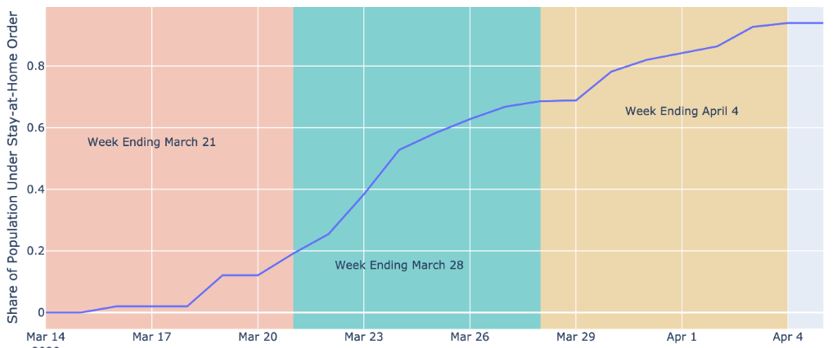
Sources: Census Bureau, The New York Times; author’s calculations.
These orders have recently come under public criticism for exacerbating the economic disruption. However, it is unclear how much of the disruption was due to the stay-at-home orders themselves and how much is due to factors that would have occurred in their absence.
In Baek et al. (2020), we take a first step in disentangling the direct effect of stay-at-home orders from the general economic disruption brought on by the coronavirus pandemic. We do so by studying the impact of such policies on initial claims for unemployment insurance, a high-frequency, regionally disaggregated indicator of real economic activity in the US.
Implementation of Stay-at-Home Orders in the US
We use data from the New York Times to track implementation of stay-at-home orders in cities, counties, and states, measuring a state’s exposure to stay-at-home orders as the average number of weeks a state’s workers were subject to the orders. By 4 April 2020, California had the highest exposure to stay-at-home orders, with workers exposed on average to two-and-a-half weeks of such orders. Conversely, five states (Arkansas, Iowa, Nebraska, North Dakota, and South Dakota) had no counties under stay-at-home policies by 4 April. Figure 2 reports exposure to stay-at-home orders for workers in each state in the US, showing that there was considerable variation between states.
Figure 2 Employment-weighted state exposure to stay-at-home policies through week ending 4 April 2020
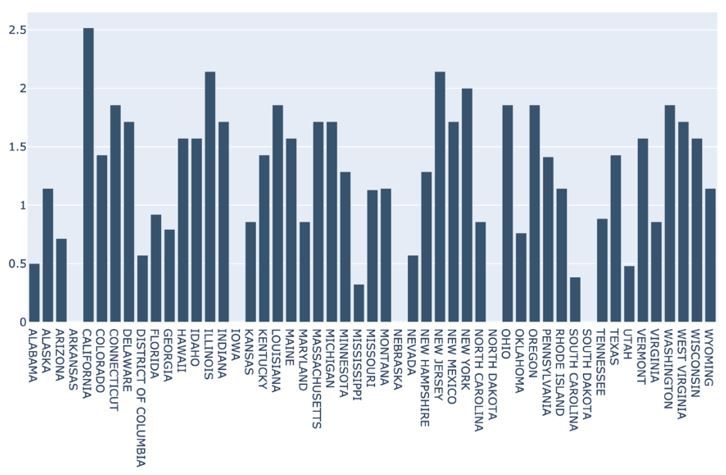
Sources: Census Bureau, The New York Times; author’s calculations.
The Effect of Stay-at-Home Orders on Unemployment Insurance Claims
To provide evidence of a causal link between the implementation of stay-at-home policies and the observed increase in unemployment insurance claims, we couple the spatial and regional variation in stay-at-home implementation with high-frequency unemployment claims data by state. This allows us to isolate the economic disruption resulting from the stay-at-home policies. To make states comparable, we scale initial claims by state employment as reported in the 2018 Quarterly Census of Employment and Wages.
We compare the evolution of scaled unemployment insurance claims of ‘early adopters’, defined as those states being in the top quartile of exposure to stay-at-home orders through 4 April, to those of ‘late adopters’, defined as those states being in the bottom quartile. As shown in Figure 3, in the first few weeks, early adopters initially had a higher rise in unemployment claims relative to late adopters. By the week ending 4 April, the relative effect of adopting stay-at-home orders early largely disappears, reflecting the fact that by this point approximately 95% of the US population was under a stay-at-home order.
Figure 3 Box plots by week of initial unemployment-insurance claims relative to employment for early and late adopters of stay-at-home policies
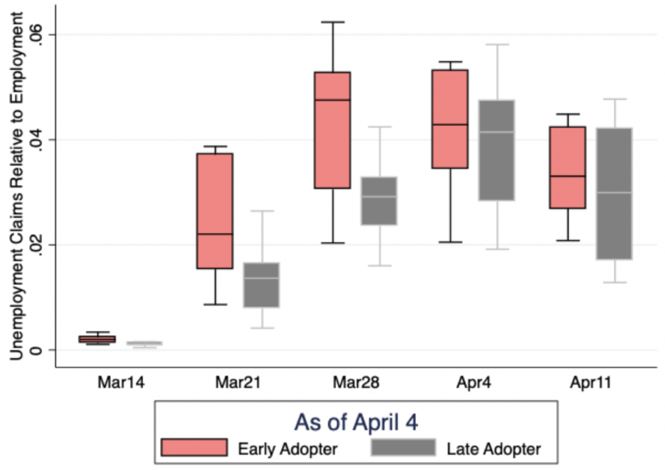
We find a positive correlation in cumulative unemployment insurance claims and our measure of stay-at-home exposure, both measured through 4 April (Figure 4). Each bubble in the figure represents a state, with the size of the bubble indicating population and the colour indicating the severity of the local, reported coronavirus outbreak.
Figure 4 Scatterplot of stay-at-home exposure to cumulative initial weekly claims for weeks ending 21 March thru 4 April
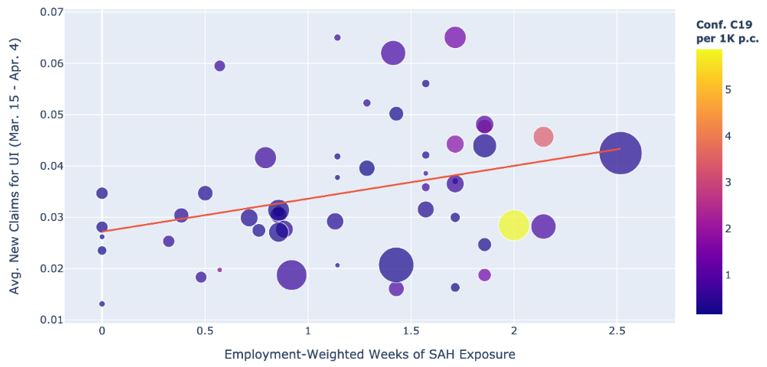
We formalise this methodology and find that an additional week of exposure to stay-at-home policies increases unemployment insurance claims by approximately 1.9% of a state’s employment level (using 2018 employment levels by state, as reported in the Quarterly Census of Employment and Wages). This result is robust controlling for factors potentially related to both stay-at-home implementation and the magnitude of new unemployment insurance claims. For example, we control for sectoral composition related to job losses occurring in the week before the first stay-at-home policy went into effect, the share of jobs likely able to be done at home, and the severity of the COVID-19 outbreak in the state.
We calculate that the direct effect of stay-at-home orders is accountable for 4 million unemployment insurance claims between 14 March and 4 April, which accounts for approximately a quarter of the overall rise in unemployment claims in that period. The direct effect of stay-at-home orders on unemployment is therefore small relative to the aggregate increase in unemployment insurance claims, suggesting that a large majority of the increase in unemployment may have occurred in the absence of such orders.
Corroborating Evidence from the Google Community Mobility Index
Along with unemployment claims, we also investigate the effect stay-at-home orders have on mobility using the Google Community Mobility Index, which tracks visits to different categories of locations (e.g. grocery stores, workplaces, or parks). We focus on mobility to retail establishments, as the main goal of stay-at-home orders was to limit non-essential business activity. The Google mobility data provide additional evidence of the effect of stay-at-home orders as it relates to a ‘demand channel’.
Figure 5 shows how a county’s retail mobility changes when stay-at-home orders are implemented (x-axis equal to 0). The extremely high-frequency nature of this data allows us to address the concern that our results are driven by anticipation effects, whereby people expect policymakers to implement stay-at-home policies imminently and reduce retail activity because the public health threat is much more salient. We find no evidence of this type of anticipation effect.
Before stay-at-home orders were implemented, retail mobility evolved similarly across counties, as evidenced by the flat line. The day they were announced, the orders reduced retail mobility by 5%. For the following two weeks, retail mobility stayed close to 10% lower relative to other counties as a result of the stay-at-home orders. Considering that during this period mobility fell by 40%, this data suggests a similar share of economic decline attributable to stay-at-home orders as the unemployment insurance data.
Figure 5 County retail mobility index
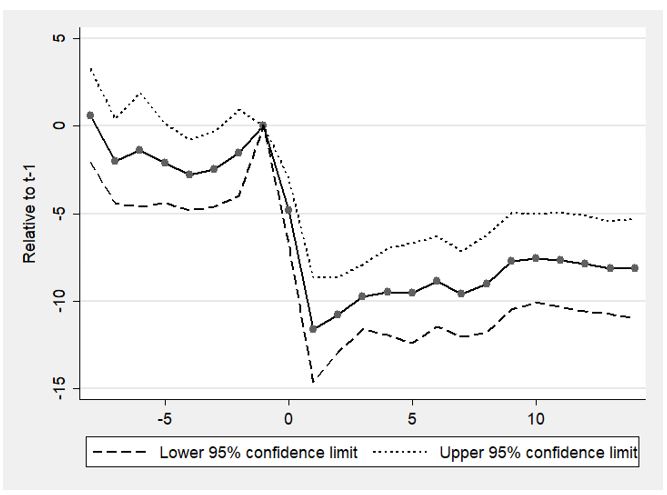
Sources: Google, The New York Times; authors’ calculations.
Policy Implications
Our results support the idea that flattening the pandemic curve implies a steepening of the recession curve in the absence of any government support (Gourinchas 2020). Stay-at-home orders account for a significant but minority share of the overall rise in unemployment claims during the pandemic, implying that much of the rise in unemployment during this period would have occurred in the absence of these orders.
This suggests that any economic recovery that arises from undoing stay-at-home orders will be limited if the underlying pandemic is not resolved. Weak consumer confidence, supply-chain disruptions, and self-imposed social distancing are just a few examples of economic headwinds that could persist even in the absence of stay-at-home orders. At the same time, the orders are likely to have public-health benefits from slowing the spread of the coronavirus.1 Taken together, our results caution policymakers not to expect the reopening of the economy to be an economic panacea.
See original post for references
_____
1 This metric has some problems. Home health care aide, nurse, and physical therapist visits to my mother would all incorrectly be deemed “non-essential,” as would visits by relatives to pick up or care for children of “essential workers” when they had to start their shifts. I would assume the people keeping track would argue it nets out across states but does it?


If the ‘results support the idea that flattening the pandemic curve implies a steepening of the recession curve in the absence of any government support’, then it would be interesting to compare it with other comparable countries that flattened the pandemic curve but gave their workers some sort of governmental support. Would that support lessen the recessional effects then?
i was about to add similar comment to Rev Kev above, because a UBI (even temporary but extending past unemployment benefits) would put $ into the economy, also undercut those who are protesting not cause of hoax belief but desperate to provide for their families.
also like to point out this LA times article and the graph of covid-19. its hitting younger folks in black/brown communities, old hard hit as well but this could be to our people being front line essential workers also disproportionately. particularly in field work and factory work. many are demanding PPE here as well.
https://www.latimes.com/california/story/2020-04-25/coronavirus-takes-a-larger-toll-on-younger-african-americans-and-latinos-in-california
I was talking to a friend the other day and they said their spouse was asked back to work for a few hours each week. It would entail taking public transportation back and forth each day in a major city. Working for a few hours then public trans back home. These few hours each week would probably negate her unemployment benefits which are significantly higher than her regular weekly pay, and the transportation and work space means more exposure to the virus.
I think there must be a lot people in this situation.
If this happens, it is still a salary loss and she will be allowed to collect unemployment on the loss in salary in most states.
Still doesn’t sound worth going.
Given the results in NYC vs other cities it appears that if authorities don’t issue SAH orders fast enough, the public doesn’t take it seriously, cases rise, and the hospital system gets slammed. The public was told for weeks running by every authority that the flu was more dangerous than COVID. The right wing media continues to say this. The disease is so contagious on its own that without SAH orders, sick people flood the hospitals.
The goal of the SAH orders was to give state authorities enough time to ramp up hospital and ICU beds before the peak of infection. It appears they haven’t been successful in ramping up testing. When the SAH orders are lifted, infections will rise. The people who don’t bother to observe social distancing will infect the rest. Hopefully the hospitals will be able to keep up.
It’s unclear to me how we can keep meatpacking plants open in an absence of testing. The sotto voce goal seems to be to let the infection spread until the workers are immune. The rest of the community is an acceptable loss.
To share an anecdote, my employer instituted universal WFH weeks before my state issued its SAH order. The state order had no effect on what we were already doing. Also, two weeks before the SAH order I went to a local restaurant on a Saturday morning and was seated immediately. In normal times there’s a 45 minute wait. So, it looks like restaurants were already being hit somewhat before the order began. This was when the first case in our state had been confirmed days earlier and there were 6 known cases statewide. Another anecdote, now that weather has turned nicer in MN I’ve noticed considerably fewer people wearing masks at the grocery store.
People are generally bad at understanding risk, but once it shows up in the flesh, they get it.
A bunch of states want to believe that it is not an issue because it hasn’t hit them hard yet. However, once it races through a meat packing plant in your town, then the mayor wants action: https://wcfcourier.com/business/local/update-waterloo-mayor-responds-to-tyson-closing-waterloo-plant/article_8c725b49-ed43-5f48-ae06-9a03d2f6e3cc.html
Many other towns assume it won’t hit them. The same thing happened in 1918-19. Many towns assumed they were isolated and they wouldn’t get it, but they did. Just several months later after the big citiies. People think tsunamis are a single big wave, but they are not the big earthquake is generating multiple big pulse throug hthe 3-4 minutes of shaking and each of those pulse becomes a tsunami wave that rolls in one after the other. These epidemics are like that until the available people to be infected declines to 50%-20% of the population and transmission slows dramatically. I expect every community in the US will get hit by this now that it is wide-spread. The biggest hope is that the doctors will know how to treat it by the time it hits areas that have not gotten it seriously yet.
BTW – places like NY did not close restaurants and bas by mid-March but many states had already seen 50% declines in traffic by then per Open Table statistics: https://www.nrn.com/news/restaurant-traffic-down-48-during-coronavirus-crisis-according-opentable
Yeah, things are weird here in the Raleigh-Durham area of North Carolina. I had to go out today to get a mouse trap which I feel is essential because I keep seeing mouse poop on my counter. But wow, so much traffic! I really could not tell there was still a stay at home order. I went to Home Depot an the mask policy seemed like ¯\_(ツ)_/¯. Even many workers not wearing masks. Chapel Hill is all service economy with plenty of bars. And even though these restaurants are doing a lot of take out, an owner of one restaurant told me they are loosing so much from lack of drink sales.
And now they said UNC will probably have the fall college semester as usual.
So will the fall be a repeat of 1919? I do not know, maybe this lax view of stay at home will make more people immune but will not be herd immunity. Besides the nursing homes here the count in the general population has been low, only 11,000 confirmed cases and only about 600 in the hospital. So is it low testing? Low infections? Since there is no good data I am not even going to guess.
Aren’t all these sick meatpackers infecting their products and passing the virus onto the consumers?
Another grand idea.
No. There is no evidence of transmission via food.
The SARS-2 coronavirus will be destroyed by the part of our digestive system that assimilates fats.
Dude, it is generally agreed the virus was transmitted by food and eating it. A few virus particles along the back the throat as the food goes down and your toast. I’m not really sure I want food from workers getting sick and dying on the job. Ok? Can we least try to solve this problem in a rational way?
Don’t spread disinformation. From the CDC:
https://www.cdc.gov/coronavirus/2019-ncov/faq.html
Similar stuff from Mayo. And the WHO:
https://www.who.int/news-room/q-a-detail/q-a-coronaviruses
ty Yves
Now that Costco has made mask wearing mandatory for both employees and customers, I hope others follow their example. Maybe we need to lobby store managers.
Before any significant stay at home orders were issued, many universities were already closed, business travel had been radically curtailed, and most trade shows, conventions, and conferences were already being cancelled within a couple months out and in uncertain land two or three months further out than that.
My own employer closed most operations on the 24th of March. Due to insufficient orders from customers nationwide. We, like all other manufacturing and warehousing operations, were exempted from New Jersey’s closure orders and our bosses would have most certainly continued to operate had there been sufficient business. The day they have sufficient orders again to call some people back would be a good month after the resumption of much more activity than just what was directly curtailed by the stay at home orders themselves.
Getting back to full staffing I suspect would take considerably longer still.
Absent another series of massive federal checks, there will at some point be a wave of state and local government personnel cuts, as their main sources of revenue have shrunk radically.
Maybe you should start showing national unemployment aggregates using an exponential curve. It doesn’t look like its going to flatten any time soon.
For the last 50 years it has been my presumption, and I think that it is pretty accurate, that you double the official unemployment figure and you can get a good approximation of actual unemployment (i.e. jobless that want to work) which includes: those who have dropped out of the workforce due to discouragement; those that are employed part-time or are underemployed and those who are still seeking work but are no longer counted because their unemployment security has run out. Let us now include those members of the precariate who are gigging and are also not counted. How these tens of millions survive is beyond me.
ShadowStats says they figure the March unemployment number to be at 23%. So the April number will be horrendous. We will be at depression levels and it doesn’t take a genius to know the average American will be wiped out. Batten down the hatches!
Dont worry guys, just hang on till November, Biden and Larry are coming to the rescue! :D
Though I will vote for him, I don’t believe Biden is left wing enough to come up with the solution to our problems. He’s more likely to believe austerity is the responsible thing. The working man will get kicked in the teeth again. There will be scandals about all the free money being handed out. Nothing will happen.
In so far as the disease goes, I’m certain he won’t have the cure for us. We will probably have a disease resurgence in the fall and maybe another in February. He wouldn’t take office until January anyway. We are just waiting for the thing to run it’s course and/or medical science to arrive at a solution.
The federal government provided $250 billion to the states for expanded unemployment.
How did it decide how much was sent to each state?
If a state doesn’t use all the funds (re-open and force people back to work), does the state have to give back the funds it didn’t use to the federal government?
Stay at home orders vs unemployment for other reasons related to Corona? Stay-at-home orders are part of the limited state policies related to Corona, so changing those orders is a policy decision. The unemployment insurance policies are also policy but are they immutable? Why does the discussion flap around the relations between equally mutable policy choices holding one of them fixed?
The unemployment problems extend far beyond the boundaries of stay-at-home orders and the great injustices which rescinding those order place on the fortunate few who manage to get unemployment checks — an injustice in-itself. We have a large population of unemployed who may never find work again if the ‘wise’ running our government and the economy continue as they have. After all the small and medium businesses shut their doors, and a lucky few are bought up by Big Money predators with FED funded deep pockets … does anyone really believe the jobs will come back and unemployment will go down?
How much of our economy may never come back in our lifetimes? How many of the restaurants and bars and the small retail shops and boutiques will magically reappear after Corona and after they pay their back rents and other postponed debt … with no income for however long Corona will last. Will some large FED funded Big Money employer take up the slack in employment? And an after thought — what will become of our State and Local governments?
What will the world look like after Corona? I would love to get a peak at the planning documents for the future that I expect accompanied, or lived in the drawer above all the plans for CARES Act re-structuring of the economy. What a wonderful world may have been planned for the future … I can only guess at its outlines.
AL may be #6, but GA is #2. We’re open for business. Give it 5 weeks. Let’s see where this goes.
Let me see if I can write this to determine if the moderation hangup is a “progressive” filter.
I live in the land of progressives. Their leaders have lots of land and lots of money. They treat workers like slaves, giving them scraps and rags, and direct them to the government agencies and non-profits where they work and volunteer.
It’s a holdup; leadership is waiting for its payday. What they call employment isn’t employment. And they talk just like the articles presented.
« They treat workers like slaves, «
That does follow. Slaves were also essential as well as expendable.
Trying to game moderation earns you troll points. Talking about it is an even bigger no.
I don’t understand either sentence. It was irony. Am I mistaken that this view of slavery was accepted by many in the not so distant past?
the comparison between the essential workers who work in abysmal conditions with little to no benefits and slavery is apt, in the sense that those whose well-being their output serves typically don’t notice it, or when its pointed out rationalize it away. those of us whose parents worked in the fields probably mirror freed descendants of slaves, our guilt at doing nothing vs survival. those at the top are hypocrites who should be called out. possibly efforts at a general strike reflect the need. we’ll see. covid-19 and its economic repercussions won’t be going away anytime soon.
This is just an amateur’s opinion, but from my reading I would say that 40% of unemployment comes from the hospitality industry, This was going to contract with and without lockdowns.
Some manufacturing job loss occurred due to supply chain disruptions.
The health care unemployment comes from well-meaning government regs,
I would blame the lockdowns for retail unemployment. The malls could have stayed open.
We must stay at home till there’s a cure or go to work without a cure. If we stay at home we definitely have costs, if we go to work we might get sick or die. So we need to calculate risks and consequences on a personal level; but we really don’t know the true number for our personal chance of getting ill or of infecting our household……….Oh dear me.